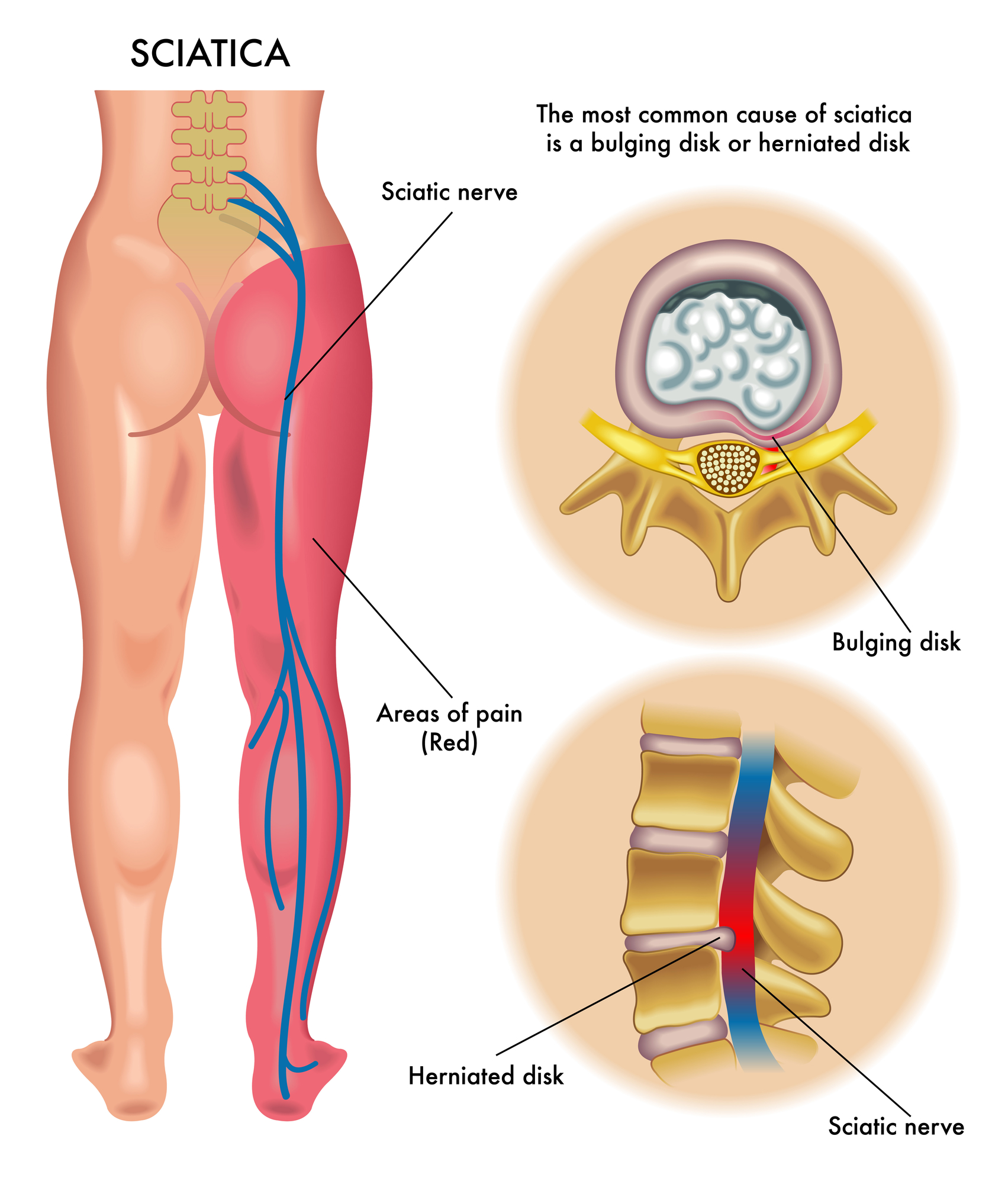
Don’t Know if it’s Sciatica?
Symptoms Include:
Not sure if your pain is truly sciatica? While back pain has many potential causes, the symptoms of sciatic nerve irritation tend to follow a recognizable pattern. Common indicators include:
- Pain radiating from the lower back down one side of the buttocks and leg
- Sharp or burning sensations that worsen when sitting
- Tingling or “pins and needles” feelings in the legs or feet
- Numbness or weakness in the lower extremities
- Difficulty standing, walking, or lifting the foot
These symptoms may come and go, or they may remain constant. In severe cases, patients may struggle to perform basic tasks such as climbing stairs or standing upright for extended periods.
What is Sciatica?
Sciatica is one of the most common—and most misunderstood—causes of lower back and leg pain. It occurs when the sciatic nerve, the longest and widest nerve in the body, becomes compressed or irritated. This nerve begins in the lower back, runs through the buttocks, and extends down the legs into the feet. Because of its size and reach, any irritation can trigger pain, numbness, tingling, or weakness along its entire pathway.
At Central Orthopedic Group, we treat patients across Long Island who suffer from sciatica, helping them regain mobility, reduce pain, and return to their normal daily activities. Whether your pain is mild and intermittent or severe and chronic, our orthopedic specialists provide the guidance and treatment you need for lasting relief.
Why Sciatic Pains Happen
There are several conditions that can lead to sciatic nerve irritation:
- Herniated Disc: One of the most common causes. A spinal disc develops a crack or bulge, pressing against the sciatic nerve.
- Degenerative Disc Disease: As we age, spinal discs naturally wear down, sometimes leading to nerve root compression.
- Piriformis Syndrome: The piriformis muscle, located deep in the buttocks, can spasm or tighten, irritating the nerve beneath it.
- Spinal Stenosis: Narrowing of the spinal canal can put pressure on the sciatic nerve roots.
- Pregnancy or Muscle Strain: Extra weight and shifting posture during pregnancy or injuries to the back muscles may trigger symptoms.
While many cases resolve within 6 weeks, others can become long-lasting and significantly impact quality of life. That’s why timely evaluation at Central Orthopedic Group’s Long Island offices is crucial.
Diagnosing Sciatica on Long Island
At our Plainview, Rockville Centre, and Massapequa locations, our physicians perform comprehensive evaluations to confirm sciatica and rule out other causes of back pain. Diagnosis may involve:
- Physical examination: Testing reflexes, strength, and range of motion.
- Imaging tests: MRI, CT scans, or X-rays to identify herniated discs, spinal stenosis, or bone spurs.
- Nerve studies: Electromyography (EMG) can show how well the sciatic nerve functions.
With an accurate diagnosis, our team can recommend the most effective treatment plan tailored to your specific condition and lifestyle.
Sciatic Pain Treatments We Offer on Long Island
Treatment for sciatica ranges from conservative options to advanced procedures. At Central Orthopedic Group, we create individualized care plans that may include:
1. Physical Therapy
Targeted exercises help strengthen back and core muscles, improve posture, and promote flexibility. Movement prevents stiffness and reduces inflammation around the sciatic nerve.
2. Ice and Heat Therapy
Ice reduces inflammation and numbs sore tissues, while heat increases blood flow and relaxes tight muscles. Alternating between the two can be highly effective for many patients.
3. Medications
Anti-inflammatory medications or muscle relaxants may be prescribed to alleviate discomfort and improve mobility.
4. Steroid Injections
For persistent pain, corticosteroid injections can provide relief by reducing swelling and irritation around the nerve roots.
5. Alternative Therapies
Gentle yoga, acupuncture, and chiropractic care may complement medical treatment, offering additional relief and improved function.
6. Surgery
In severe cases where conservative methods fail after several weeks, surgery may be recommended. Options include microdiscectomy (removing part of a herniated disc) or laminectomy (removing part of the vertebra to relieve pressure).
Living with Sciatic Pain: Lifestyle and Prevention
While medical treatment is essential, lifestyle adjustments can also make a significant difference:
- Regular Exercise: Low-impact activities like walking, swimming, or yoga strengthen core muscles.
- Ergonomic Adjustments: Correct posture at work and supportive seating reduce back strain.
- Healthy Weight: Maintaining a healthy body weight minimizes stress on the spine.
- Safe Lifting Techniques: Bending from the knees instead of the waist protects the back.
Our orthopedic specialists work closely with patients, providing both immediate relief and long-term strategies to prevent flare-ups.
Why Choose Central Orthopedic Group for Sciatic Pain on Long Island?
When it comes to treating sciatic pain, experience matters. At Central Orthopedic Group, our team of board-certified orthopedic physicians and specialists has been serving Long Island patients for decades. We provide:
- Comprehensive diagnostics and personalized treatment plans
- State-of-the-art facilities in Plainview, Rockville Centre, and Massapequa
- Advanced pain management techniques and minimally invasive procedures
- Compassionate care with a patient-first approach
Whether your pain is new or chronic, our mission is to help you return to a pain-free, active lifestyle as quickly and safely as possible.
Take the First Step Toward Relief
You don’t have to live with sciatic pain. At Central Orthopedic Group, we provide comprehensive care for patients across Long Island who are struggling with this condition. From accurate diagnosis to advanced treatment options, our team is here to help you find lasting relief.
Contact us at our Long Island offices in Plainview, Rockville Centre, or Massapequa to get started on your path to recovery.
Frequently Asked Questions About Sciatic Pain
How do I know if my pain is sciatica?
If your pain radiates from the lower back through the buttock and down the leg, especially on one side, it’s likely sciatica. A proper medical evaluation can confirm the diagnosis.
Can sciatic pain go away on its own?
Yes, some cases resolve within weeks. However, persistent or severe pain should be evaluated by an orthopedic specialist to prevent long-term damage.
When should I see a doctor?
If your pain lasts more than a few weeks, worsens over time, or is accompanied by significant numbness, weakness, or loss of bladder/bowel control, seek immediate medical attention.
What treatments are available at Central Orthopedic Group?
We offer physical therapy, medication, injections, and surgical options when necessary, all customized to your condition and goals.
Do you accept new patients on Long Island?
Yes! We welcome new patients at our Plainview, Rockville Centre, and Massapequa offices.

